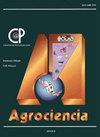FORAGE YIELD AND COMPOSITION OF BLACK OAT IN MONOCULTURE AND IN ASSOCIATION WITH WINTER VETCH
IF 0.5
4区 农林科学
Q4 AGRICULTURE, MULTIDISCIPLINARY
引用次数: 0
Abstract
Associated grass-legume pastures have advantages over grass monoculture; in order to evaluate them the association of black oat (Avena strigosa Schreb) with winter vetch (Vicia villosa Roth) was analysed. The objective of the study was to evaluate forage yield, the botanical, morphological, and chemical composition of black oat in monoculture and in association with winter vetch, at different crop heights and residual stubble heights. Eighteen treatments were evaluated in randomized complete blocks with divided plots. In large plots, the culture type (monoculture or association); and in small plots, nine harvest management options (combinations) of three crop heights (Ch: 40, 50 and 60 cm) and three residual stubble heights (Rsh: 8, 14 and 20 cm). Forage yield was higher (p ≤ 0.05) in Ch50-Rsh8, Ch60-Rsh8 and Ch60-Rsh14 during the second crop cycle, with an average 8555 kg DM ha-1. In monoculture and in association, more cuts were made (three to four) with Ch40-Rsh14 and Ch40-Rsh20 and fewer cuts (one to two) with Ch60-Rsh8, Ch60-Rsh14 and Ch60-Rsh20. Crude protein concentration was 19 % higher (p ≤ 0.05) in monoculture than in association (19.2 and 16.2 %); the highest concentrations (p ≤ 0.05) of crude protein were obtained in Ch40-Rsh8, Ch40-Rsh14 and Ch40-Rsh20 (average 20.5 %), and the lowest was recorded in Ch60-Rsh8 (13.2 %). The forage with the least neutral detergent fibre (p ≤ 0.05) was harvested in Ch40-Rsh8, Ch40-Rsh14 and Ch50-Rsh14 (average 43.4 %), and the highest (49.3 %) was obtained in Ch60-Rsh20. In monoculture and in association, a greater amount of forage was harvested, distributed in at least two harvests, with Ch of 50 and 60 cm in combination with 8 and 14 cm of Rsh. However, the forage did not have the best composition, due to higher concentrations of neutral detergent fibre and lower crude protein concentration.单作黑燕麦的饲料产量和组成及与冬野豌豆的关系
草-豆科牧草联种比单作牧草有优势;为了评价黑燕麦(Avena strigosa Schreb)与冬野豌豆(Vicia villosa Roth)的关系。本研究的目的是评价在不同作物高度和残茬高度下,单作黑燕麦和与冬野豌豆杂交的黑燕麦的饲料产量、植物学、形态学和化学成分。18个处理在随机的完整块中进行评估。在大地块,栽培类型(单一栽培或联合栽培);在小块土地上,采用三种作物高度(Ch: 40、50和60 cm)和三种残茬高度(Rsh: 8、14和20 cm)的九种收获管理方案(组合)。第二作物周期Ch50-Rsh8、Ch60-Rsh8和Ch60-Rsh14的牧草产量最高(p≤0.05),平均8555 kg DM ha-1。在单作和联合栽培中,Ch40-Rsh14和Ch40-Rsh20切割次数较多(3 ~ 4次),Ch60-Rsh8、Ch60-Rsh14和Ch60-Rsh20切割次数较少(1 ~ 2次)。单作组粗蛋白质浓度分别比联合组(19.2%和16.2%)高19% (p≤0.05);Ch40-Rsh8、Ch40-Rsh14和Ch40-Rsh20的粗蛋白质含量最高(p≤0.05),平均为20.5%,Ch60-Rsh8最低(13.2%)。Ch40-Rsh8、Ch40-Rsh14和Ch50-Rsh14的中性洗涤纤维含量最低(p≤0.05)(平均43.4%),Ch60-Rsh20的中性洗涤纤维含量最高(49.3%)。在单作和组合中,收获的牧草量较大,分布在至少两次收获中,ch50和60 cm, Rsh为8和14 cm。然而,由于中性洗涤纤维浓度较高,粗蛋白质浓度较低,因此饲料的组成不是最佳的。
本文章由计算机程序翻译,如有差异,请以英文原文为准。
求助全文
约1分钟内获得全文
求助全文
来源期刊

Agrociencia
农林科学-农业综合
CiteScore
0.50
自引率
33.30%
发文量
51
审稿时长
18-36 weeks
期刊介绍:
AGROCIENCIA is a scientific journal created and sponsored by the Colegio de Postgraduados. Its main objective is the publication and diffusion of agricultural, animal and forestry sciences research results from mexican and foreign scientists. All contributions are peer reviewed. Starting in the year 2000, AGROCIENCIA became a bimonthly and fully bilingual journal (Spanish and English versions in the same issue). Since 2007 appears every month and a half (eight issues per year). In addition to the printed issues, the full content is available in electronic format.
 求助内容:
求助内容: 应助结果提醒方式:
应助结果提醒方式:


